The Copernicus Sentinel-4 mission, scheduled to begin by July 2025, is set to mark a turning point for air quality monitoring in Europe and North Africa.
When taken into orbit from a fixed earth-measured location 36,000 km above the Earth, Sentinel-4 provides hourly high-resolution data on major air pollutants.
Unlike its predecessor, Sentinel-4 doesn’t just provide daily snapshots. Instead, it provides real-time tracking of pollutants such as nitrogen dioxide, ozone and other harmful trace gases that fluctuate rapidly due to traffic, industrial activities and weather patterns.
This shift to hourly updates has been welcomed as a breakthrough in air quality predictions, allowing for faster and more accurate responses to contamination events.
“The Sentinel-4 is a complete game-changer for air quality prediction.” – Ben Veihelmann, Sentinel-4 and Sentinel-5 mission scientists from ESA.
Why the orbital position is important
The Sentinel-4 is unique in that it operates from a geostationary orbit and allows for continuous monitoring of the same region.
Unlike low-Earth orbit satellites that only pass through the same location once a day, Sentinel-4 maintains a constant field of view in parts of Europe and North Africa.
This orbit allows satellites to scan target areas hourly, capturing rapid changes in air pollution driven by human activity and weather conditions.
This ability to detect hourly variation is important for understanding pollutant transport and transformation, making it a game changer for short-term air quality predictions and public health advisories.
Advanced technology for trace gas detection
At the heart of the mission is a highly refined UVN (UV, visible, near-infrared) imaging spectrometer that can detect micro-concentrations of harmful gases and aerosols.
By analyzing sunlight that passes through the atmosphere or reflected from the Earth’s surface, Sentinel-4 can identify contaminant spectra “fingerprints” and determine concentrations.
This data helps track the vertical distribution of materials such as ozone and sulfur dioxide, providing insight into not only ground level pollution, but also how pollutants behave across the atmosphere.
International collaboration for global impact
The Sentinel-4 mission is a joint effort between the European Space Agency (ESA), the European organization for exploitation of weather satellites, and EumetSat.
The Sentinel-4 equipment is mounted on the weather satellite, Meteosat Third Sounder (MTG-S), and combines two missions into one platform to maximize efficiency.
This mission is also part of a global air quality surveillance initiative from space. Along with NASA’s tempo (for North America) and Korean gems (for Asia), Sentinel-4 contributes to the constellations of Earth-layer satellites that provide a collective, almost continuous coverage of the most densely concentrated regions of the Northern Hemisphere.
This international coordination is extremely important as air pollution does not respect borders.
Turning air quality data into actionable insights
All data generated by Sentinel-4 supports a wide range of services and stakeholders, is openly accessible and free to use.
Among the main beneficiaries are Copernicus Atmospheric Monitoring Services (CAMS) and Copernicus Climate Change Services, both of which integrate data into operational models and forecasts.
This information will help public agencies issue timely air quality alerts, verify compliance with environmental regulations, and assess progress towards emission reduction targets.
Beyond governance, Sentinel-4 data supports scientific research, supports the solar industry, and even informs aviation decisions by tracking volcanic emissions.
Strengthening public health and policy
One of the most important impacts of the mission is in the field of public health.
By providing detailed and timely information on contamination levels, Sentinel-4 helps protect vulnerable populations, such as those with breathing conditions, by enabling health warnings and exposure mitigation strategies.
Satellite data also helps policymakers by informing evidence-based decisions and tracking the effectiveness of environmental laws.
This represents an important step in transforming scientific capabilities into real-world behavior and promoting healthier, more resilient communities.
Game changer in air quality monitoring
With advanced instrumentation, unique track locations and joint foundations, the Sentinel-4 mission is committed to redefine the landscape of air quality monitoring.
By providing high-frequency, high-resolution data on air pollutants, it enhances understanding of and strengthens its ability to combat air pollution.
With Europe preparing for the launch of its satellites in mid-2025, expectations are built within the scientific, environmental and public health community.
Sentinel-4 is more than just another satellite. This is a powerful tool to make breathing easier in the coming years.
Source link

